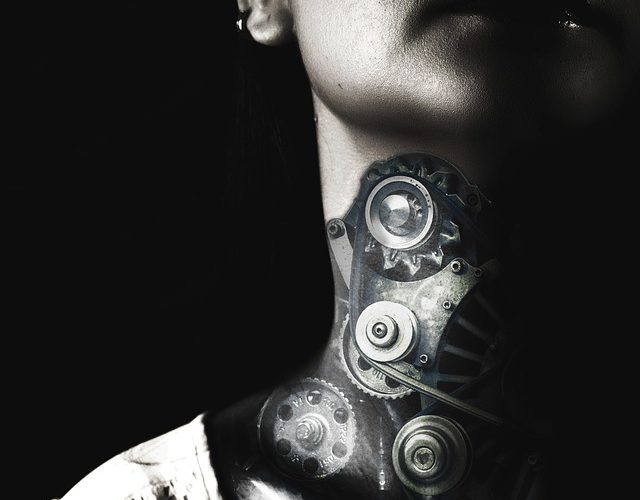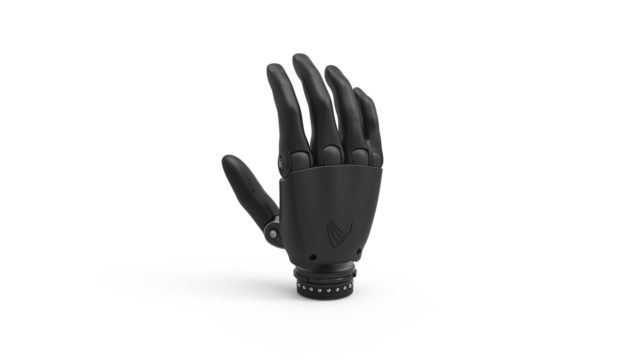Arrival of the Cyborg?

Bionic technologies are no longer the stuff of science fiction, and with hundreds of thousands of users worldwide, they have bridged the gap between humans and computer technology. Bionics are any type of technology that produces a movement or action within the human body that is usually performed biologically. They can be electromechanical devices with moving parts, such as robotic prosthetic limbs, exoskeletons and motorized joint braces, or static devices such as those used for hearing or vision replacement1, or for translating thoughts into speech2. This article delves into the world of electromechanical bionic devices.
How are bionics controlled?
Bionics are controlled using electrical signals recorded from the body, called biosignals, which give insight into the movement or intentions of the user. Usually, activity within muscles or the brain is recorded, and hybrid technologies may read both types of signals. The recording of electrical activity in muscles is known as electromyography (EMG).
Sensors are used to capture biosignals, and there are two ways to interface the sensors with the body: invasively and non-invasively. Invasive sensors are placed in direct contact with the region generating the signal; for EMG, this involves using a sensor with a needle to penetrate the muscle to be monitored, whilst for brain activity, this involves a surgical procedure to place the sensors in direct contact with the regions of interest in the brain. Invasive technologies give accurate signals which are ideal for control, as can be seen in the brain-computer interface developed by researchers at Caltech, which enables fine control of prosthetics by quadriplegics3. But it comes at a cost. In the case of invasive muscular sensing, the cost is discomfort and possible infection, whilst in the case of brain signal technology, it is the risks and long-term effects of major surgery. Non-invasive technologies mitigate these issues by placing sensors on the surface of the skin, over the muscle or scalp region of interest. These low-risk technologies are more practical and appealing, particularly for non-biomedical applications. However, signals recorded non-invasively are of a poorer quality when compared to those recorded invasively. This is because the signals of interest can get mixed with signals from neighbouring muscular or brain regions as they travel from their point of origin to the surface of the skin, making it difficult to extract important information when compared to invasive technologies. This makes it difficult to produce robust systems with fine, accurate control. However, improved sensors and computer processing techniques have led to viable non-invasive technologies. For example, the NHS is looking into clinical trials for prosthetic limbs using non-invasive muscular sensors4, new sensing technology has enabled a musician to play the piano following an amputation5, and a non-invasive brain-computer interface has enabled individuals suffering from paralysis to walk again6.
Algorithms are used to extract the intentions of the user from these biosignals. In EMG sensing, electrical activity within muscles is related to contraction and relaxation associated with attempted movements7. Brain-signals, however, can be used in various ways to control bionics: they can be used to identify which option on a menu the user is looking at8, an object they are thinking of, or a body movement they are imagining9. In the case of remotely controlled robots, brain signals can be used to identify the kind of movement the user is trying to execute so that it can be mirrored by the robot.
Some cutting-edge bionic devices can also pass feedback signals into the human brain or nervous system, providing the user with the sensation of touch10.
Where are bionics used?
In the biomedical sphere, bionics can be used to replace or restore lost motor functionality, for example through amputees using prosthetic limbs, or through assistive walking technologies for patients with Parkinson’s disease11. In particular, EMG-controlled robotic limbs have had a huge impact on the quality of life of amputees worldwide. For example, prosthetic legs that closely mimic muscle movements have enabled one man to walk and run following the amputation of part of his legs after a mountain climbing accident12, and 3D-printed prosthetics13 have enabled child amputees to benefit from robotic prosthetics which can be changed regularly as they grow — something which was more difficult in the past due to the prohibitively high cost of more traditional prosthetics14.

New prosthetic technologies are moving beyond pure EMG and introducing new sensing technology. For example, a novel line of prosthetics uses pressure sensors to interpret movement within the muscles of a residual limb. These sensors can be used in conjunction with EMG technology to make intuitive interfaces, like the one which has enabled athlete Danny Letain to have finer control of his prosthetic arm. In the future, this kind of combined-sensor technology could enable users to thread a needle or to carry an egg without breaking it due to excessive pressure15. Bionics are also widely used for rehabilitation following illness or injury, for example in gait training after a stroke or traumatic brain injury16.
However, the applications of bionics reach beyond the biomedical sphere. They have a strong industrial and military potential because they can be used to enhance the human body, particularly its strength and stamina17. They can also be used to remotely control electromechanical arms operating in dangerous environments with finer precision than the widely used button and joystick control methods. They could also be used to enhance the gaming experience through finer control and sensory feedback, for example through special gaming or virtual reality gloves18.
Double-Edged Sword?
Bionic technologies are changing lives worldwide but, as with any groundbreaking technology, it presents a double-edged sword. Abuses can be rife — biosignal data, particularly brain signal data, contains highly personal information about health and cognitive functionality, which could be exploited for extortion or illicit data mining. Systems that provide feedback to the user, such as prosthetics which produce electrical signals to give a sensation of touch, offer access to manipulate the human body. Recent research indicates that a wide variety of medical devices are vulnerable to hacking19, and this connection to the human brain would need to be safeguarded from subversive control. Furthermore, long-term use of bionics could lead to the brain interpreting the technology as a part of the individual’s body — as if it were their own limb. This leads to questions such as whether intentional damage to a bionic device constitutes bodily harm or merely damage to personal property. Finally, technologies enhancing the human body could be weaponized if they were poorly regulated, could be abused during conflict or by any private company selling them. Issues such as these create a shadow in the wake of every great technological revolution, and it’s important for designers and policymakers to consider them so that future developments can be guided by ethics and safeguards.
The arrival of the cyborg in our society is nigh — it’s an exciting time to be alive.
This article was specialist edited by Anna Henschel and copy-edited by Madeline Pritchard.
References
- https://www.bbc.co.uk/news/av/technology-48501600/goggles-give-back-sight-to-maisy-so-she-can-read-again?fbclid=IwAR26Ak2IrtTS3Zook4jvthH8vmL6BY5vzPE-LzlgjTEUTzZLd_vJ0-bwUeE
- https://www.nytimes.com/2019/04/24/health/artificial-speech-brain-injury.html?smid=fb-nytimes&smtyp=cur&fbclid=IwAR01b94L90cAHVXnwN7LFhmCryrPLh8pqZvnDayehTc73K_Jf8L06wM6pJU
- https://www.caltech.edu/about/news/controlling-robotic-arm-patients-intentions-46786
- https://inews.co.uk/news/health/the-ten-health-innovations-that-could-soon-be-on-the-nhs/ ,
- https://healthcare-in-europe.com/en/news/how-an-amputee-controls-prosthetic-fingers-like-luke-skywalker.html
- https://www.popsci.com/paralyzed-patients-regain-partial-movement-using-brain-controlled-device
- https://openbionics.com/how-does-a-bionic-arm-work/
- https://youtu.be/8eOSlzDdOpg
- https://www.cybathlon.informatik.tu-darmstadt.de/Research/Brain-ComputerInterfacing
- https://youtu.be/FUqgVHR6mpQ
- https://www.the-scientist.com/features/next-generation-exoskeletons-help-patients-move-30126
- https://www.ted.com/talks/hugh_herr_how_we_ll_become_cyborgs_and_extend_human_potential?language=en
- https://openbionics.com/
- https://insights.globalspec.com/article/9980/affordable-prosthetics-through-3d-printing
- https://www.eurekalert.org/pub_releases/2016-05/sfu-srb050416.php
- https://youtu.be/jlz9tpUo6ww
- https://www.outerplaces.com/science/item/17117-exoskeleton-legs-soldiers
- https://haptx.com/
- https://www.theguardian.com/technology/2018/aug/09/implanted-medical-devices-hacking-risks-medtronic










